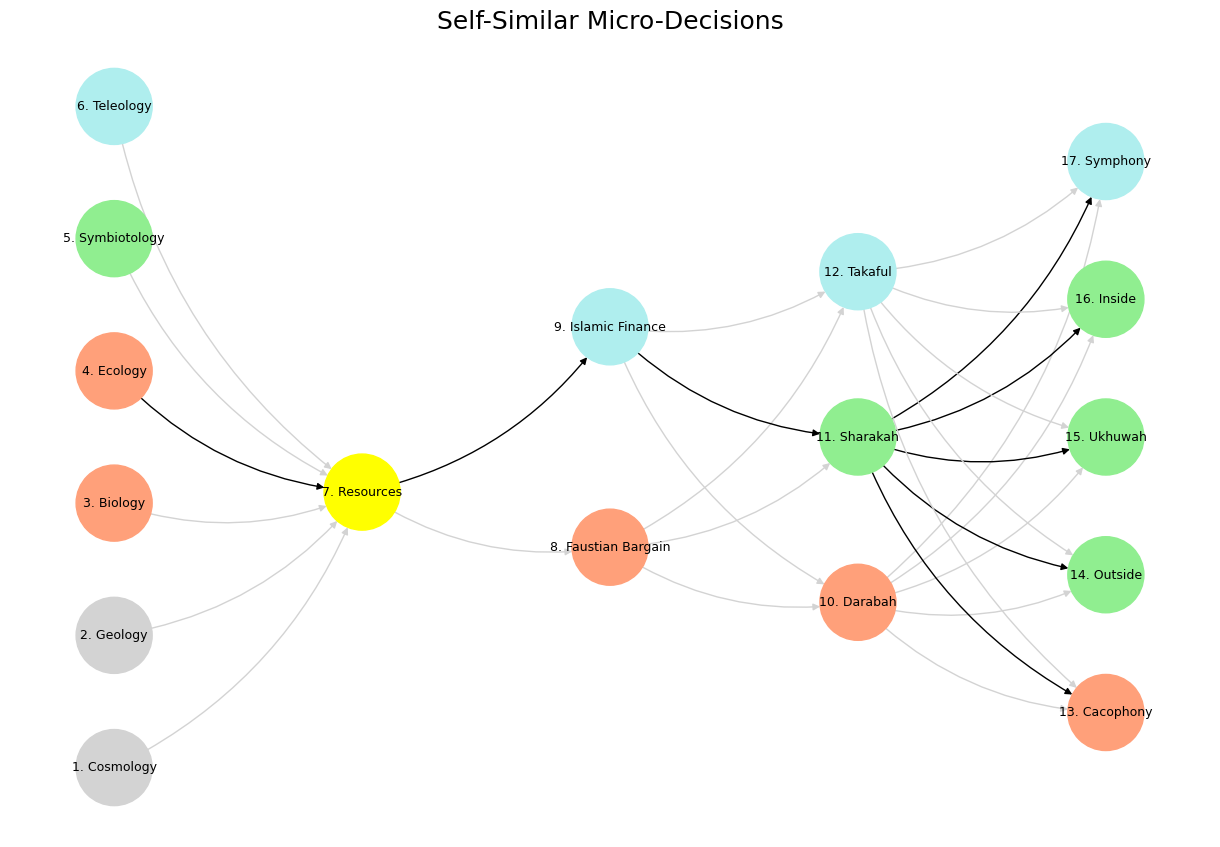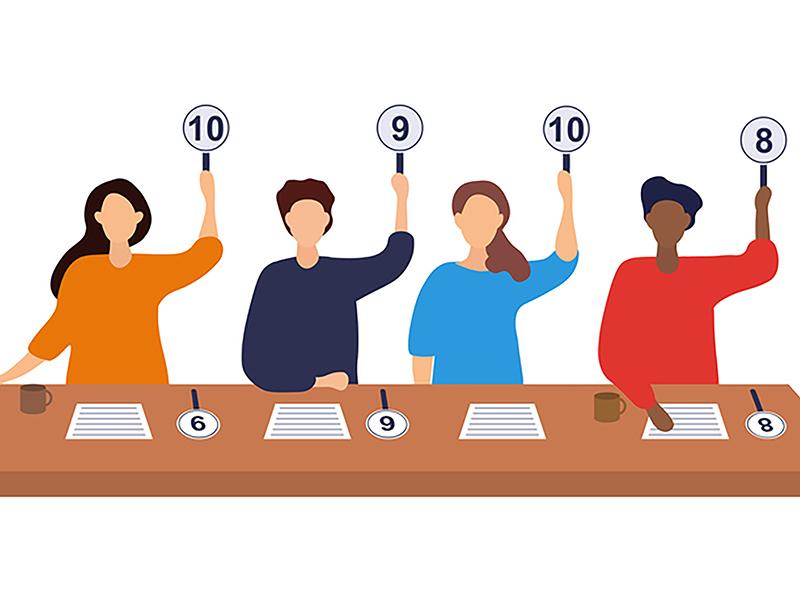Duality#

Semaglutide, a glucagon-like peptide-1 receptor agonist, has been shown to reduce the risk of adverse cardiovascular events in patients with diabetes. Whether semaglutide can reduce cardiovascular risk associated with overweight and obesity in the absence of diabetes is unknown.
Entropy: Wisdom (Streets)
Resources: Vigilance (Owl)
Faustian: Noise (Molecule) vs. Signal (Epitope)
Distributed: Self (Helmet), Negotiable (Shield), Nonself (Spear)
Illusion: Harmony (Lyre)
— Inverted Tree

Pattern recognition and speculation are instinctive and vestigual aspects of our complex neural, endocrine, and immune systems.
Show code cell source
import numpy as np
import matplotlib.pyplot as plt
import networkx as nx
# Define the neural network layers
def define_layers():
return {
'Tragedy (Pattern Recognition)': ['Cosmology', 'Geology', 'Biology', 'Ecology', "Symbiotology", 'Teleology'],
'History (Resources)': ['Resources'],
'Epic (Negotiated Identity)': ['Faustian Bargain', 'Islamic Finance'],
'Drama (Self vs. Non-Self)': ['Darabah', 'Sharakah', 'Takaful'],
"Comedy (Resolution)": ['Cacophony', 'Outside', 'Ukhuwah', 'Inside', 'Symphony']
}
# Assign colors to nodes
def assign_colors():
color_map = {
'yellow': ['Resources'],
'paleturquoise': ['Teleology', 'Islamic Finance', 'Takaful', 'Symphony'],
'lightgreen': ["Symbiotology", 'Sharakah', 'Outside', 'Inside', 'Ukhuwah'],
'lightsalmon': ['Biology', 'Ecology', 'Faustian Bargain', 'Darabah', 'Cacophony'],
}
return {node: color for color, nodes in color_map.items() for node in nodes}
# Define edges
def define_edges():
return [
('Cosmology', 'Resources'),
('Geology', 'Resources'),
('Biology', 'Resources'),
('Ecology', 'Resources'),
("Symbiotology", 'Resources'),
('Teleology', 'Resources'),
('Resources', 'Faustian Bargain'),
('Resources', 'Islamic Finance'),
('Faustian Bargain', 'Darabah'),
('Faustian Bargain', 'Sharakah'),
('Faustian Bargain', 'Takaful'),
('Islamic Finance', 'Darabah'),
('Islamic Finance', 'Sharakah'),
('Islamic Finance', 'Takaful'),
('Darabah', 'Cacophony'),
('Darabah', 'Outside'),
('Darabah', 'Ukhuwah'),
('Darabah', 'Inside'),
('Darabah', 'Symphony'),
('Sharakah', 'Cacophony'),
('Sharakah', 'Outside'),
('Sharakah', 'Ukhuwah'),
('Sharakah', 'Inside'),
('Sharakah', 'Symphony'),
('Takaful', 'Cacophony'),
('Takaful', 'Outside'),
('Takaful', 'Ukhuwah'),
('Takaful', 'Inside'),
('Takaful', 'Symphony')
]
# Define black edges (1 → 7 → 9 → 11 → [13-17])
black_edges = [
(4, 7), (7, 9), (9, 11), (11, 13), (11, 14), (11, 15), (11, 16), (11, 17)
]
# Calculate node positions
def calculate_positions(layer, x_offset):
y_positions = np.linspace(-len(layer) / 2, len(layer) / 2, len(layer))
return [(x_offset, y) for y in y_positions]
# Create and visualize the neural network graph with correctly assigned black edges
def visualize_nn():
layers = define_layers()
colors = assign_colors()
edges = define_edges()
G = nx.DiGraph()
pos = {}
node_colors = []
# Create mapping from original node names to numbered labels
mapping = {}
counter = 1
for layer in layers.values():
for node in layer:
mapping[node] = f"{counter}. {node}"
counter += 1
# Add nodes with new numbered labels and assign positions
for i, (layer_name, nodes) in enumerate(layers.items()):
positions = calculate_positions(nodes, x_offset=i * 2)
for node, position in zip(nodes, positions):
new_node = mapping[node]
G.add_node(new_node, layer=layer_name)
pos[new_node] = position
node_colors.append(colors.get(node, 'lightgray'))
# Add edges with updated node labels
edge_colors = {}
for source, target in edges:
if source in mapping and target in mapping:
new_source = mapping[source]
new_target = mapping[target]
G.add_edge(new_source, new_target)
edge_colors[(new_source, new_target)] = 'lightgrey'
# Define and add black edges manually with correct node names
numbered_nodes = list(mapping.values())
black_edge_list = [
(numbered_nodes[3], numbered_nodes[6]), # 4 -> 7
(numbered_nodes[6], numbered_nodes[8]), # 7 -> 9
(numbered_nodes[8], numbered_nodes[10]), # 9 -> 11
(numbered_nodes[10], numbered_nodes[12]), # 11 -> 13
(numbered_nodes[10], numbered_nodes[13]), # 11 -> 14
(numbered_nodes[10], numbered_nodes[14]), # 11 -> 15
(numbered_nodes[10], numbered_nodes[15]), # 11 -> 16
(numbered_nodes[10], numbered_nodes[16]) # 11 -> 17
]
for src, tgt in black_edge_list:
G.add_edge(src, tgt)
edge_colors[(src, tgt)] = 'black'
# Draw the graph
plt.figure(figsize=(12, 8))
nx.draw(
G, pos, with_labels=True, node_color=node_colors,
edge_color=[edge_colors.get(edge, 'lightgrey') for edge in G.edges],
node_size=3000, font_size=9, connectionstyle="arc3,rad=0.2"
)
plt.title("Self-Similar Micro-Decisions", fontsize=18)
plt.show()
# Run the visualization
visualize_nn()

Fig. 9 Dynamic Capability. The monumental will align adversarial TNF-α, IL-6, IFN-γ with antigens from pathogens of “ancient grudge”, a new mutiny with antiquarian roots. But it will also tokenize PD-1 & CTLA-4 with specific, emergent antigens, while also reappraising “self” to ensure no rogue viral and malignant elements remain unnoticéd.#
Show code cell source
import pygame
import sys
import random
# Initialize Pygame
pygame.init()
# Constants
SCREEN_WIDTH = 800
SCREEN_HEIGHT = 600
PADDLE_WIDTH = 20
PADDLE_HEIGHT = 100
BALL_SIZE = 20
BRICK_WIDTH = 40
BRICK_HEIGHT = 20
BRICK_COLUMNS = 5
BRICK_ROWS = 30 # 600 / 20 = 30 rows to span screen height
PADDLE_SPEED = 5
BALL_SPEED = 5
TARGET_SCORE = 50
# Colors
BLACK = (0, 0, 0)
WHITE = (255, 255, 255)
RED = (255, 100, 100)
GREEN = (100, 255, 100)
BLUE = (100, 100, 255)
# Set up display
screen = pygame.display.set_mode((SCREEN_WIDTH, SCREEN_HEIGHT))
pygame.display.set_caption("Break-Pong")
clock = pygame.time.Clock()
# Paddle class
class Paddle:
def __init__(self, x, y):
self.x = x
self.y = y
self.width = PADDLE_WIDTH
self.height = PADDLE_HEIGHT
self.speed = PADDLE_SPEED
def move(self, up=True):
if up:
self.y -= self.speed
else:
self.y += self.speed
# Keep paddle within screen bounds
self.y = max(0, min(SCREEN_HEIGHT - self.height, self.y))
def draw(self):
pygame.draw.rect(screen, WHITE, (self.x, self.y, self.width, self.height))
# Ball class
class Ball:
def __init__(self):
self.reset()
self.size = BALL_SIZE
def move(self):
self.x += self.vel_x
self.y += self.vel_y
def reset(self):
self.x = SCREEN_WIDTH // 2
self.y = SCREEN_HEIGHT // 2
self.vel_x = random.choice([-1, 1]) * BALL_SPEED
self.vel_y = random.choice([-1, 1]) * BALL_SPEED
self.last_hit = None # Tracks which paddle last hit the ball
def draw(self):
pygame.draw.circle(screen, WHITE, (int(self.x), int(self.y)), self.size // 2)
# Brick class
class Brick:
def __init__(self, x, y):
self.x = x
self.y = y
self.width = BRICK_WIDTH
self.height = BRICK_HEIGHT
self.color = random.choice([RED, GREEN, BLUE])
self.intact = True
def draw(self):
if self.intact:
pygame.draw.rect(screen, self.color, (self.x, self.y, self.width, self.height))
# Particle class for visual effects
class Particle:
def __init__(self, x, y):
self.x = x
self.y = y
self.size = random.randint(2, 5)
self.vel_x = random.uniform(-2, 2)
self.vel_y = random.uniform(-2, 2)
self.life = 30 # Frames until particle disappears
self.color = random.choice([RED, GREEN, BLUE])
def update(self):
self.x += self.vel_x
self.y += self.vel_y
self.life -= 1
def draw(self):
if self.life > 0:
alpha = int((self.life / 30) * 255) # Fade out effect
surface = pygame.Surface((self.size, self.size), pygame.SRCALPHA)
pygame.draw.circle(surface, (*self.color, alpha), (self.size // 2, self.size // 2), self.size // 2)
screen.blit(surface, (int(self.x), int(self.y)))
# Collision detection functions
def ball_collides_with_paddle(ball, paddle):
return (ball.x - ball.size // 2 < paddle.x + paddle.width and
ball.x + ball.size // 2 > paddle.x and
ball.y - ball.size // 2 < paddle.y + paddle.height and
ball.y + ball.size // 2 > paddle.y)
def ball_collides_with_brick(ball, brick):
if not brick.intact:
return False
return (ball.x - ball.size // 2 < brick.x + brick.width and
ball.x + ball.size // 2 > brick.x and
ball.y - ball.size // 2 < brick.y + brick.height and
ball.y + ball.size // 2 > brick.y)
# Initialize game objects
left_paddle = Paddle(50, SCREEN_HEIGHT // 2 - PADDLE_HEIGHT // 2)
right_paddle = Paddle(SCREEN_WIDTH - 50 - PADDLE_WIDTH, SCREEN_HEIGHT // 2 - PADDLE_HEIGHT // 2)
ball = Ball()
# Create central brick wall
bricks = []
brick_start_x = SCREEN_WIDTH // 2 - (BRICK_COLUMNS * BRICK_WIDTH) // 2
for col in range(BRICK_COLUMNS):
for row in range(BRICK_ROWS):
bricks.append(Brick(brick_start_x + col * BRICK_WIDTH, row * BRICK_HEIGHT))
# Scores and particles
left_score = 0
right_score = 0
particles = []
# Game loop
running = True
while running:
# Event handling
for event in pygame.event.get():
if event.type == pygame.QUIT:
running = False
# Paddle movement
keys = pygame.key.get_pressed()
if keys[pygame.K_w]:
left_paddle.move(up=True)
if keys[pygame.K_s]:
left_paddle.move(up=False)
if keys[pygame.K_UP]:
right_paddle.move(up=True)
if keys[pygame.K_DOWN]:
right_paddle.move(up=False)
# Update ball
ball.move()
# Ball collisions with top/bottom walls
if ball.y - ball.size // 2 <= 0 or ball.y + ball.size // 2 >= SCREEN_HEIGHT:
ball.vel_y = -ball.vel_y
# Ball collisions with paddles
if ball_collides_with_paddle(ball, left_paddle):
ball.vel_x = abs(ball.vel_x) # Ensure ball moves right
ball.last_hit = 'left'
elif ball_collides_with_paddle(ball, right_paddle):
ball.vel_x = -abs(ball.vel_x) # Ensure ball moves left
ball.last_hit = 'right'
# Ball collisions with bricks
for brick in bricks:
if ball_collides_with_brick(ball, brick):
brick.intact = False
ball.vel_x = -ball.vel_x
# Add particles
for _ in range(5):
particles.append(Particle(brick.x + brick.width // 2, brick.y + brick.height // 2))
# Award points
if ball.last_hit == 'left':
left_score += 1
elif ball.last_hit == 'right':
right_score += 1
# Ball off screen
if ball.x - ball.size // 2 <= 0:
right_score += 5
ball.reset()
elif ball.x + ball.size // 2 >= SCREEN_WIDTH:
left_score += 5
ball.reset()
# Update particles
for particle in particles[:]:
particle.update()
if particle.life <= 0:
particles.remove(particle)
# Draw everything
screen.fill(BLACK)
for brick in bricks:
brick.draw()
left_paddle.draw()
right_paddle.draw()
ball.draw()
for particle in particles:
particle.draw()
# Draw scores
font = pygame.font.Font(None, 36)
left_text = font.render(f"Left: {left_score}", True, WHITE)
right_text = font.render(f"Right: {right_score}", True, WHITE)
screen.blit(left_text, (50, 20))
screen.blit(right_text, (SCREEN_WIDTH - 150, 20))
# Check for game over
if left_score >= TARGET_SCORE or right_score >= TARGET_SCORE:
winner = "Left" if left_score >= TARGET_SCORE else "Right"
game_over_text = font.render(f"{winner} Wins!", True, WHITE)
screen.blit(game_over_text, (SCREEN_WIDTH // 2 - 50, SCREEN_HEIGHT // 2))
pygame.display.flip()
pygame.time.wait(3000)
running = False
pygame.display.flip()
clock.tick(60)
# Cleanup
pygame.quit()
sys.exit()
Show code cell output
An exception has occurred, use %tb to see the full traceback.
SystemExit
The Kernel crashed while executing code in the current cell or a previous cell.
Please review the code in the cell(s) to identify a possible cause of the failure.
Click <a href='https://aka.ms/vscodeJupyterKernelCrash'>here</a> for more info.
View Jupyter <a href='command:jupyter.viewOutput'>log</a> for further details.

